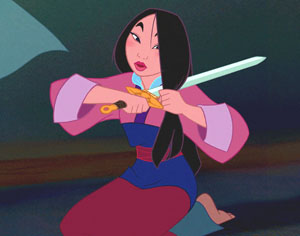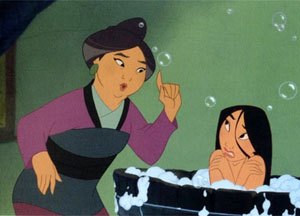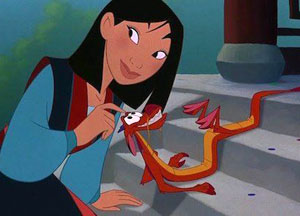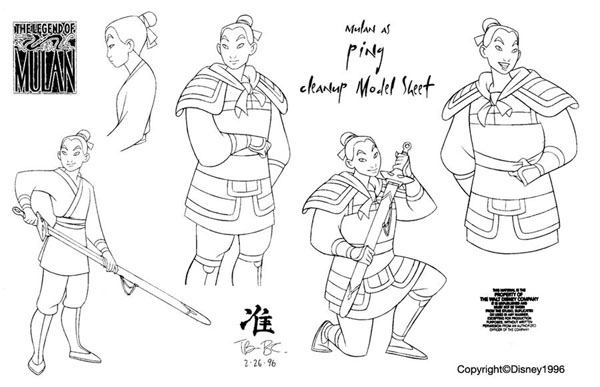
Suspended Animation #386
Mulan (1998) was the first full Disney animated feature done primarily by the Disney Feature Animation Florida studio that had previously done sequences for other Disney feature films as well as several Roger Rabbit cartoon shorts. On its initial release it grossed $120 million in the United States and Canada combined, and $304 million worldwide, making it the second-highest grossing family film of the year, behind A Bug’s Life.
 I was working at Walt Disney World in the animation department of the Disney Institute at the time of its production and was able to visit the animation building and see some of the work in progress.
I was working at Walt Disney World in the animation department of the Disney Institute at the time of its production and was able to visit the animation building and see some of the work in progress.
I was also able to attend an event held there in 1998 for a limited number of WDW cast members where some people involved in the film talked about it before showing the film. There was some sort of publicity tour at the time with a massive Mulan parade debuting at Disney MGM Studios featuring more performers and more expensive costumes than any other Disney theme park parade so some of the voice actors were available.
Here are some of my notes. I haven’t seen these quotes elsewhere although I am sure the people involved may have said something similar over the years but in the interests of documenting animation history I thought it was important to share them here.

Based on an ancient Chinese poem, the story is about a young woman who takes the place of her aged father when he is required to rejoin the army to defend against the invasion of the Huns.
Fa Mulan (speaking voice by Ming-Na Wen, singing voice by Lea Salonga) disguises herself as a man and is advised in her adventures by a pint-sized, feisty talking dragon named Mushu (voiced by Eddie Murphy), who claims he has been assigned by the Fa family spiritual guardians.
 The film was co-directed by Barry Cook and Tony Bancroft. At the event, Cook remarked, “Mulan is unique among the spectrum of Disney heroines because she doesn’t want to change herself.”
The film was co-directed by Barry Cook and Tony Bancroft. At the event, Cook remarked, “Mulan is unique among the spectrum of Disney heroines because she doesn’t want to change herself.”
Actress Ming-Na Wen said, “ It has always been one of my dreams to be in a Disney animated film and I’m excited that I got to do one. It has been fascinating to watch the character develop and to see my gestures and nuances become part of Mulan.
“This has been as creatively satisfying as any project I’ve been a part of. By removing the make-up, costumes and sets, I’ve felt more free to use my imagination than ever before.”
Supervising animator of the character Mulan Mark Henn added, “Ming-Na was a joy to work with. She brought such a spark and a life to the character and a spirit that made my job that much easier.
“She created a performance in front of the microphone that helped feed my mind and visualize what I was thinking. Watching her helped me to create the performance on paper when it came time to do the animation.”
Lea Salonga said, “Getting the part of Mulan was amazing. My heart felt like it was going to burst. Not too many people get to be part of this experience and I’m fortunate that this is my second time. To be involved in the making of another Disney animated feature is fantastic. And because I’m Asian, this particular project is extra special. It’s a really cool thing.”
 She also provided the singing voice for princess Jasmine in Disney’s 1992 animated feature Aladdin.
She also provided the singing voice for princess Jasmine in Disney’s 1992 animated feature Aladdin.
Tom Bancroft, supervising animator of Mushu said he watched Eddie Murphy’s movies and analyzed printouts of the actor’s facial expressions.
Bancroft said, “Eddie’s voice provided a lot to work with. He gave such a brilliant and hilarious reading that it challenged me to come up with something really worthy.”
Pat Morita, perhaps best remembered for the television series Happy Days and the movie Karate Kid, was cast as the emperor and he joked, “I think I am typecast again. I’m playing a guy who is old, regal, benevolent, warm, caring and dynamic, yet simple. The emperor is a real caring guy. He rules with an iron fist but he also has a very generous heart.
“I’ve done some animated roles and voice-over work in the past but this is the first time I’ve ever witnessed the animation process from idea to story sketch to finished art and it fascinates me.”

The presentation focused on the innovations of the Digital Production Department at Walt Disney Feature Animation Florida. Supervising animator of CGI Rob Bekuhrs said, “There are more computer generated imagery elements in this film than there ever in any Disney film before.”
 Eric Guaglione, the film’s computer animation artistic supervisor shared, “The sequence where the Huns are attacking is much more complicated than say the wildebeest stampede in The Lion King. Not only do you have nearly 2,000 soldiers on horseback in this scene but they have different costumes, swords and spears. A variant of this software was used to have 3,000 unique figures in the Forbidden City at the end of the film.
Eric Guaglione, the film’s computer animation artistic supervisor shared, “The sequence where the Huns are attacking is much more complicated than say the wildebeest stampede in The Lion King. Not only do you have nearly 2,000 soldiers on horseback in this scene but they have different costumes, swords and spears. A variant of this software was used to have 3,000 unique figures in the Forbidden City at the end of the film.
“We’ve taken a whole new approach to creating this kind of action, and it gives us greater control over individual movements and more flexibility than ever before. Our goal is to ‘plus’ the film by using CGI…to make it richer and more beautiful than ever before, but ultimately we do hope than no one will notice what we do.
“We want the audience to be thinking what a beautifully crafted film this is and how well all the components fit together, not ‘Wow, what a great computer generated effect!’”
Cook added, “What I like about the way CGI is used in Mulan is that we just didn’t use it on one big scene but found different applications for it throughout the film which really supported the action.
“I don’t think it’s so much that technology has improved but that directors and art directors are getting a better grasp of the tools.”
CGI was used to create seventeen different animated elements throughout the film including gently swaying bamboo, flaming arrows, munitions carts, a multitude of colorful banners and nearly seven thousand lit lanterns dispersed throughout the crowd for the film’s finale. In nearly every case, the CGI elements were combined with hand-drawn character animation created with pencil and paper.
 The audience was also told some “behind the scenes” information to help see the film a little differently including that caricatures of the directors Barry Cook and Tony Bancroft appear as the firework attendants frightened by Mushu in the climax.
The audience was also told some “behind the scenes” information to help see the film a little differently including that caricatures of the directors Barry Cook and Tony Bancroft appear as the firework attendants frightened by Mushu in the climax.
When Mulan sings “Reflection” in her father’s shrine, the writings on the temple stones are the names of the Disney animators who worked on the film written in ancient Chinese (embed below).
In the summer of 1994, several members of the production team spent three weeks in China gathering information and sketching. The animators also utilized the China pavilion at Epcot because of its architectural authenticity.
Songwriter Stephen Schwartz wrote the music and lyrics for three songs for the film but left the production to work on Dreamworks animated feature The Prince of Egypt (1998). Jeffrey Katzenberg threatened to have Schwartz’s name removed from all publicity material for Pocahontas and Hunchback of Notre Dame. Schwartz’s songs were removed from the film.


 Jim Korkis is an internationally respected animation historian who in recent years has devoted his attention to the many worlds of Disney. He was a columnist for a variety of animation magazines. With his former writing partner, John Cawley, he authored several animation related books including The Encyclopedia of Cartoon Superstars, How to Create Animation, Cartoon Confidential and Get Animated’s Animation Art Buyer’s Guide. He taught animation classes at the Disney Institute in Florida as well as instructing classes on acting and animation history for Disney Feature Animation: Florida.
Jim Korkis is an internationally respected animation historian who in recent years has devoted his attention to the many worlds of Disney. He was a columnist for a variety of animation magazines. With his former writing partner, John Cawley, he authored several animation related books including The Encyclopedia of Cartoon Superstars, How to Create Animation, Cartoon Confidential and Get Animated’s Animation Art Buyer’s Guide. He taught animation classes at the Disney Institute in Florida as well as instructing classes on acting and animation history for Disney Feature Animation: Florida.




















































“Mulan is unique among the spectrum of Disney heroines because she doesn’t want to change herself.” I hope I’m not missing something here, but as far as I can see none of the Disney heroines really wanted to change themselves. (There was Ariel, yes, who had to transform physically in order to survive on dry land, but that was merely a precondition to her wish and not the wish itself.) Characters like Snow White, Cinderella, and Belle were more concerned about changing the circumstances that surrounded them.
“Jeffrey Katzenberg threatened to have [Stephen] Schwartz’s name removed from all publicity material for Pocahontas and Hunchback of Notre Dame.” Katzenberg left Disney in 1994 to co-found Dreamworks, and he was executive producer of “The Prince of Egypt”. If anything, it seems as though he might have brought Schwartz along with him to Dreamworks and maybe helped him get out of his contract with Disney. Are you sure it wasn’t another Disney executive who wanted to take Schwartz’s name off those films?
In any case, they must have repaired the rift, for Schwartz later returned to Disney to write the lyrics for “Enchanted”. It’s a shame his songs weren’t used in “Mulan”. Stephen Schwartz is one of the giants of American musical theatre, and his work on “Pocohontas” was absolutely brilliant.
My mistake. It was Eisner who threatened and then removed Schwartz’s songs. Always glad for the corrections from knowledgeable people on this site. I had Katzenberg’s name in my notes but it obviously referred to something else and I made the mistaken connection.
JIm
You describe yourself above as an “internationally respected animation historian”, and “devoted his attention to the many worlds of Disney”
Why don’t you simply admit you made an honest mistake in typing the article – and didn’t notice it during proofreading?
Instead, you dismiss it (when writing about one of the most tempestuous events of DIsney history following Frank Wells death, and Katzenberg’s defection to Dreamworks) as ” it obviously referred to something else and I made the mistaken connection”..
That’s lawyer talk.
It would be equivalent to Jerry writing on this blog next week that Bugs Bunny was a Disney character – because he misread something he’d written.
I have invested in a number of your books, but am troublingly having second thoughts about their information value.
When someone tells me something that I know not to be true – followed by a dubious excuse – , it causes me to doubt things they have told me of which I have lesser knowledge.
Mike Barrier, in my belief a genuine respected animation historian, is only too happy to admit when he’s wrong.
Everybody makes honest mistakes, inadvertently types something they wish they hadn’t. –
But only the “respected” will admit when they clearly erred.
Which Jim has clearly done.
Not sure why this bee is in your bonnet – I’ll correct the text for future readers of this blog (which unlike a book is designed to be easily updated and corrected). Jim and I appreciate (and encourage) corrections from you and all readers.
I’ll also be removing your comment above, which serves no real purpose except to tear down a “respected” historian over an honest mistake.
No.
According to your article:
“Songwriter Stephen Schwartz wrote the music and lyrics for three songs for the film but left the production to work on Dreamworks animated feature The Prince of Egypt (1998). Jeffrey Katzenberg threatened to have Schwartz’s name removed from all publicity material for Pocahontas and Hunchback of Notre Dame”
This is not correct.
Jeffrey Katzenberg CO-FOUNDED Dreamworks in 1994.
According to collider.com:
“Schwartz was approached by Katzenberg to write songs for The Prince of Egypt”
“Schwartz was confronted by Peter Schneider, the president of Disney Animation, who threatened to remove his name from publicity for his other Disney projects Pocahontas and The Hunchback of Notre Dame. Eventually Schwartz received a call by CEO Eisner as well. When Schwartz refused to quit working with DreamWorks on The Prince of Egypt, Eisner booted him from Mulan.”
https://collider.com/mulan-alternate-version-stephen-schwartz/
Jim has already corrected his mistake.
See Jim’s reply above.
“Songwriter Stephen Schwartz wrote the music and lyrics for three songs for the film but left the production to work on Dreamworks animated feature The Prince of Egypt (1998). Jeffrey Katzenberg threatened to have Schwartz’s name removed from all publicity material for Pocahontas and Hunchback of Notre Dame. Schwartz’s songs were removed from the film.”
Because Heaven forbid a free-lance creative talent work for anyone other than Disney alone.
Some people who work for the Disney Channel once told me that Disney employees have a saying:
“The Mouse Is Mean.”
Dear Mr. Korkis, I’m sorry people are rude to you. I enjoy your articles – mistakes and all – none of us is perfect. Please keep doing what you do.
Hear, hear.
The internet & social media are full of what I call the “gunslinger mentality”. There are certain people who read something not to enjoy or learn, but specifically to seek out and pounce upon error with the goal of triumphantly CORRECTING…
Totally agree and it’s getting way too out of hand these days, unfortunately.
Having just finished Disneywar about the tumultuous reign of Emperor Eisner I suspected his vindictiveness in the removal efforts. However, since I have also found myself accidentally working in a corporate environment I have also observed the vicious nature of the upward bound as they vie to be the next seated on the throne so it could have been anyone really.
Thanks for correcting it.